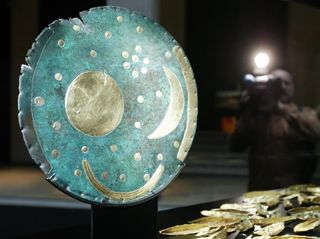Göbekli Tepe. (Image credit: Ayzenstayn/Getty Images)
Sweatman’s research includes chemical engineering and statistical mechanics as well as studies in archaeoastronomy. His team’s work made headlines in 2021 when they suggested a comet slammed into our planet 13,000 years ago based on finding a lot of platinum in sites of North America and Greenland. (Platinum can be formed in areas of high temperatures, including in the case of meteor strikes.)
The theory of the comet strike event, called the Younger Dryas impact hypothesis, dates back to a 2007 peer-reviewed paper in the Proceedings of the National Academy of Sciences led by nuclear physicist Richard Firestone, according to the New York Times Magazine. The theory remains debated by specialists to this day, some of whom say (for example) that the findings could account for a rapidly cooling climate that was not necessarily sparked by a comet fall.
Sweatman’s 2021 paper said these counterarguments were from a “small cohort of researchers” whose claims are “poorly constructed.” Yet the debate is in fact fairly wide-ranging and mainstream, according to a 2018 report in Science News, as experts continue to examine aspects such as why there is no suspect crater linked to the Younger Dryas impact, and what remnants the comet may have left behind.
Related: 40 years ago, a comet came out of the blue in a surprise Earth flyby. Here’s what we know now.

Pillars at Göbekli Tepe, one of the oldest known ancient farming communities in the world, in Sanliurfa, Turkey. (Image credit: Ozan Kose/AFP via Getty Images)
Assuming the comet impact was true, Sweatman’s group says they re-examined a set of V-shaped symbols carved across several pillars at Göbekli Tepe. Their work suggests that if each V was a single day, the community accurately marked the 365-day solar calendar.Â
Adding credence to this theory is a special entry for the summer solstice, “represented by a V worn around the neck of a bird-like beast thought to represent the summer solstice constellation at the time,” the researchers wrote in the University of Edinburgh release. “Other statues nearby, possibly representing deities, have been found with similar V-markings at their necks.”

Engravings are seen on a T-shaped pillar at the Göbekli Tepe archaeology site. (Image credit: Chris McGrath/Getty Images)
Additionally, two enclosures (labeled C and D in the study) are made up of 11 T-shaped pillars. When interpreted alongside other archaeological sites in the region that gave special significance to the number 11, the study team says this is evidence that the inhabitants of Göbekli Tepe were also tracking the 11 full phases of the moon in a 365-day solar year.
As for the comet strike, the team says the evidence for that lies on what they call Pillar 18, located in Enclosure D. The pillar is a person-like or anthropomorphic shape that has a horizontal “head” and a vertical “body”, according to the peer-reviewed study in Time and Mind. Also visible on the pillar is a belt buckle and fox-pelt loincloth that is drawn in the possible shape of a comet, the researchers say.

The Nebra sky disk, dating from the second millennium BCE. It depicts the sun, the moon and possible other astronomical shapes. At bottom is a shape that has been interpreted as a comet, a mythological boat, an aurora or a rainbow. (Image credit: Sebastian Willnow/DDP/AFP via Getty Images)
The possible comet shape on Pillar 18 may be reminiscent to that of the Nebra sky-disk, a second millennium BCE artifact unearthed in modern-day Germany, the study team argues. The disk shows the moon, sky, a grouping of stars that could be interpreted as the Pleiades and (perhaps most contentiously) a comet.Â
The comet, if it is indeed on the disc, is represented by a “long, curved shape incised with parallel lines,” the Göbekli Tepe team writes.Â
But the comet hypothesis is not fully agreed upon by researchers of Nebra; others have suggested it depicts a mythological boat or a rainbow, Astronomy Magazine wrote in 2021. Or the shape may be an aurora borealis, according to a short report in Physics Today that same year.
Source link : http://www.bing.com/news/apiclick.aspx?ref=FexRss&aid=&tid=66b4fd2d4a3b42f38fc4b1c9db2a515b&url=https%3A%2F%2Fwww.space.com%2Fcomet-strike-13000-years-ago-world-oldest-solar-calendar-gobekli-tepe-turkey&c=10117501068781327402&mkt=en-us
Author :
Publish date : 2024-08-08 03:58:00
Copyright for syndicated content belongs to the linked Source.












